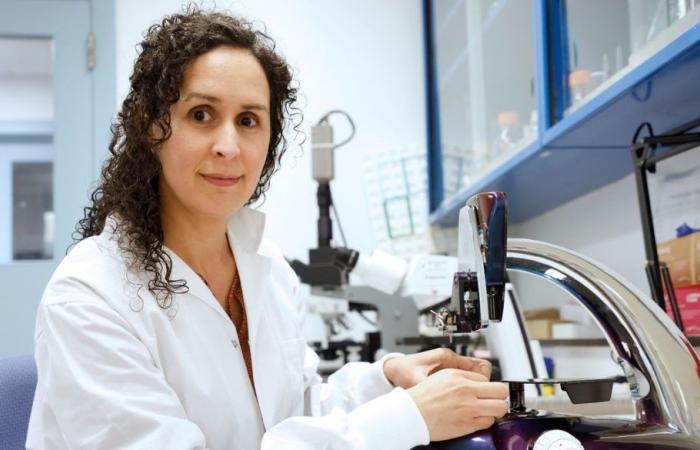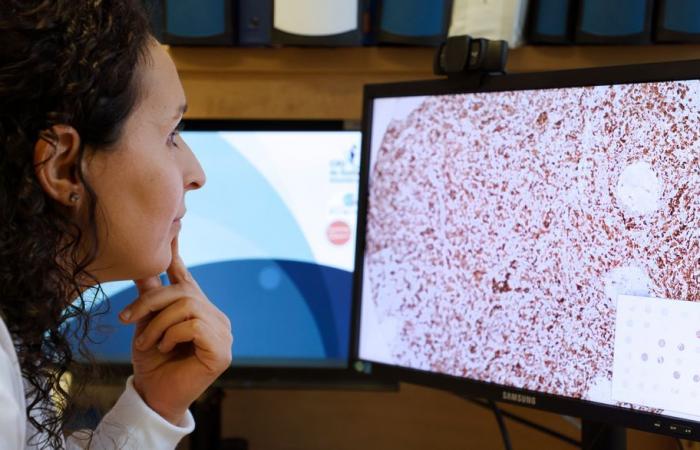The Research Samples series chronicles the experiences of members of the student research community. They share an overview of their graduate project.
“Everyone, close or distant, has a history of breast cancer. It’s so common,” says Kaoutar Ennour-Idrissi, doctoral student in epidemiology and resident in pathology, who saw three mothers in her entourage succumb to the disease.
Her doctoral project, under the direction of Professors Caroline Diorio and Francine Durocher, focuses on the effectiveness of an anti-estrogen treatment used for hormone-dependent breast cancers and the influence of breast adipose tissue. “After menopause, it is adipocytes, fat cells, which produce estrogen in women,” explains Kaoutar. As the tumor is immersed in breast adipose tissue, we wanted to determine its characteristics and see its effect on response to treatment. If weight plays a role, we may wonder if it is possible to adjust the dose or use a drug with another mechanism of action. The study also concerns premenopausal patients, for whom treatment is prescribed to induce menopause, in addition to anti-estrogens.
Kaoutar works with cohorts of patients, a contact that she really enjoys. “I wanted to be closer to reality, closer to patients, by combining molecular biology with epidemiology.”
For this project, 160 patients were recruited at the Deschênes-Fabia Breast Disease Center, located at Saint-Sacrement Hospital. They were grouped into two categories: those who responded well to treatment and those who responded less well. Kaoutar wanted to find markers or factors in patients that influence the prognosis of the disease and the response to treatment to better personalize the therapeutic approach.
During her project, Kaoutar tested adipose tissue and blood samples to measure patients’ estrogen levels before treatment and six months after treatment. Among the influencing factors, Kaoutar focuses on the epigenetic profile of fat cells which influences their functioning and the level of estrogen before the start of treatment.
Kaoutar selected and harvested adipose tissue from paraffinized blocks to construct tissue microarrays to concentrate the DNA.
— Yan Doublet
Go see what’s happening inside the cell
Kaoutar followed an atypical path, motivated by her desire to understand the disease. “I started by studying medicine, because I wanted to help, to feel useful,” she says. During my internships, I realized that there was often a need for a pathological examination, with the naked eye and under a microscope, to explain the anomalies and direct towards the right treatment. This is what led to his specialization in pathology, but it wasn’t enough to answer all his questions.
— Kaoutar Ennour-Idrissi, doctoral student in epidemiology and resident in pathology
“I wanted to zoom in even more, to see what was happening inside the cell.” Kaoutar suspended his training to develop research expertise. She completed a master’s degree in clinical epidemiology and embarked on a doctorate.
Combining clinical and research
In parallel with his doctoral project, Kaoutar resumed his residency in pathology as part of the Clinician-Researcher Training Program. “Not everyone embarks on this adventure. It brings challenges, but also a lot of professional fulfillment and satisfaction.”
Kaoutar wants to work as a clinician-scientist, sharing half her time seeing patient cases and the other half doing research. She thus wishes to guide her work by questions that arise in the clinic and guide pathology practices through her research. “That’s where I think I can make a difference, because there aren’t a lot of clinician-scientists in breast cancer pathology.”
Kaoutar often shows photos of the disease during public presentations to explain how it forms.
— Yan Doublet
Kaoutar received several scholarships for her project, including the Vanier scholarship in 2017. She emphasizes that this financial support helped her in her doctoral journey and that it will contribute to her career. “I think it will help me stand out, it will help me in my file as a clinician-scientist to obtain grants.”
Popularization occupies an important place in Kaoutar’s life, who enjoys making presentations to the general public. Throughout her journey, she noted a lack of understanding of the disease, even within the cohort for her project. “A significant proportion of patients did not take the treatment, even if it was prescribed, because they did not know its usefulness. There is a need to be filled,” reports the doctoral student and resident. She would like to set up a project to answer patients’ questions and explain the disease to them.







